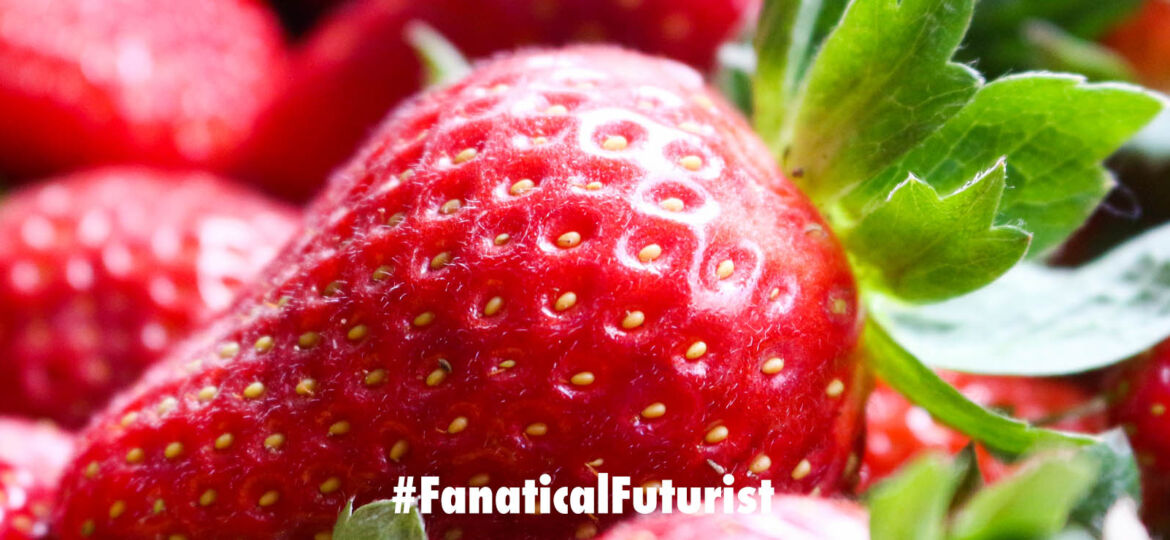
WHY THIS MATTERS IN BRIEF
Dramatic improvements in AI, machine vision, robotics, and sensors, mean robots are finally matching humans in many tasks.
 Love the Exponential Future? Join our XPotential Community, future proof yourself with courses from XPotential University, connect, watch a keynote, or browse my blog.
Love the Exponential Future? Join our XPotential Community, future proof yourself with courses from XPotential University, connect, watch a keynote, or browse my blog.
Over the past few years agricultural robots have come on leaps and bounds with growers, packers, and retailers using a host of new machines that range from drones and robots that can autonomously plant, tend, and harvest entire crops, all the way through to the use of fully autonomous vertical farms, fruit picking robots, and many more. Although, ironically, with the emergence of 3D printed artificial fruit at some point in the future none of these particular technologies might actually be needed …
One of the hardest nuts to crack though has been the development robotic harvesters because in many cases fruits, such as apples, oranges, kiwis and berries, are not only delicate, but they’re also really fiddly to pick.
There have been breakthroughs though with the development of robots that can pick apples, oranges, and raspberries up to 60 percent faster than human pickers, but getting to those speeds, using a combination of advanced AI, machine vision, and new robotic systems, has been difficult.
However, while there are now an increasing number of companies that are developing increasingly sophisticated agricultural robots, such as Octinion, Dogtooth Technologies and Fieldwork Robotics, one company that has been successfully grappling with these challenges is the Spanish start-up Agrobot.
See Agrobot go to work in the fields
Ten years ago, it set about developing a strawberry picking robot for growers facing worsening labour shortages. The result is a giant steel octopus on wheels, with 24 picking arms that work together to pluck the fruit off up to four rows of strawberry plants at a time. Its giant wheels roll up and down the spaces between plants and Agrobot’s Chief Executive and founder Juan Bravo insists it can be adapted to any row spacing or farm configuration.
Suitable for both tabletop and open-field harvesting, the robot has been trialled by Driscoll’s in California since 2015, and Agrobot is hoping to launch the technology commercially very soon.
“Our technology has been improved a lot over the last ten years,” says Bravo. “We’ve had to change the design many times but we’re now very happy with the latest prototype.”
Like other tech companies in its field one of Agrobot’s main challenges has been in matching manual picking speeds – not an easy task given humans’ dexterity, efficiency and precision in such tasks, but even in just the past year the year they’ve made huge strides with the picking speed, going from 7.4 seconds per fruit in 2019 to just 3 then just 1.2 seconds in 2020.
“We kept increasing the speed of our robotic arms until we reached three seconds per strawberry,” recalls Bravo, “but we had to slow this down to one every five seconds because the robotic arm was dropping fruit.”
The average human picking speed in California is significantly faster, at 1.2 seconds a strawberry, but Bravo says Agrobot can compete with humans by harvesting with several robotic arms simultaneously.
“Our robots’ arms might be slower but there are more of them,” he says.
Another big challenge is locating the fruit on the plant – something Bravo says has been made much easier by advances in AI.
“Agrobot can pick up to 80 per cent of the strawberries in the field, sometimes 50 or 60 per cent – it depends how the strawberries are presented on the plant and whether they’re visible outside the canopy.”
Further progress in this area will depend not only on advancing the robot, but more importantly on improving growing practices and strawberry varieties.
“We need to adapt the plants to the harvester and the harvester to the plants,” says Bravo. “This will take a few more years because we’ll have to involve more companies and more people.” For the time being, workers are therefore still needed to pick the remaining fruit on the plants, but Bravo says it’s a good start.
Beyond speed and efficiency, food safety is also of central importance. And in order to minimise the contact between the picking arm and the strawberry, Bravo has adapted his robot to pick by the stem – the norm in both the UK and Asia.
“This is not only to avoid bruising but mainly for food safety,” he explains. “If the robotic arm is touching one strawberry’s skin after another, the potential for spreading diseases is high.”
When it comes to target markets, he says that along with California, the UK is “very interesting”. According to the NFU fruit picker shortages reached 17.6 per cent in August last year, with the pilot SAWS scheme falling well short of fulfilling growers’ labour requirements.
“I’ve spoken to several British growers,” says Bravo. “We decided not to test the robot there because we couldn’t spread ourselves too thin, but if all goes to plan, the robot should be available there within the next year or two.”
Ultimately, the goal is to develop safe, profitable harvesters not just for strawberries but for other crops too. And amid intensifying labour shortages, funding has been flowing in – initially from Spanish and European grants, then from growers in California and now from “other industry players”.
“Growers really need this kind of technology,” says Bravo. “And we think we’re very close to launching it.”

















[…] that pick fruit faster than humans are already being tested in farms; accelerated mine prospecting with drill […]